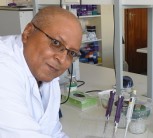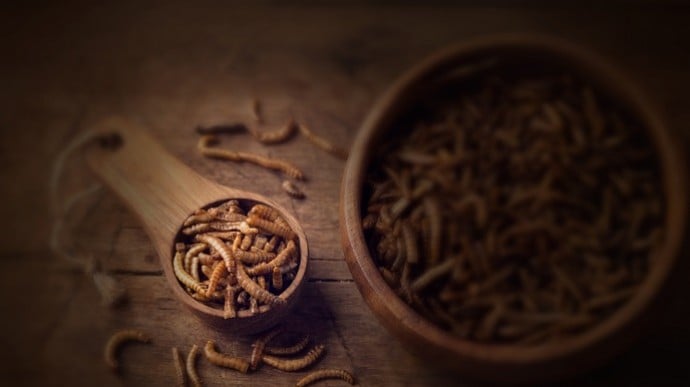Researchers at the University of Pretoria (UP) are producing unique nanobodies that could be of ground-breaking use in rapid tests and as a therapy for COVID-19. In tests conducted in collaboration with the National Institute for Communicable Diseases (NICD), the nanobodies have been shown to neutralise SARS-CoV-2 in cells.
“Nanobodies can also be used to design ‘dipstick’ tests, to test saliva, and produce a result in a few minutes, like a pregnancy test. These can be used in communities and homes for COVID-19 diagnosis. They can also be used in an airport testing centre,” says Professor Tahir (TS) Pillay, Head of Pathology and Chemical Pathology at the UP/National Health Laboratory Service, Steve Biko Academic Hospital, who is leading this research. “For example, before flying abroad, passengers can be tested, will get the result within 30 minutes and be allowed to check in or not.” His nanobody prototype test has been selected for the semi-finals of the 2020 GAP Innovation Competition: Biosciences, which is being hosted by the Innovation Hub in partnership with the Technology Innovation Agency and Emory University’s Goizueta Business School.
“Nanobodies are one-tenth the size of conventional antibodies, which makes them easier to work with while there is an urgent need for good, cheap, sensitive rapid tests for COVID-19,” he says. Currently, international airports such as Heathrow and airlines like Emirates are setting up testing centres where they will use nucleic acid testing to identify people who might have COVID-19 and could therefore be infectious. Another potential test is serology, which tests for antibodies, meaning if you have a high level of antibodies, you might be “safe” to travel and are unlikely to be carrying the virus.
There is also an antigen test, which detects the virus by identifying its proteins. This type of test could be cheaper to produce on a mass scale if the sensitivity is good enough. “However, antigen detection tests are not widely used because the development of these has been more recent and they might not be sensitive enough,” Prof Pillay says.
He explains that all these tests use conventional antibodies, which are temperature-sensitive (they need to be kept cold), are expensive to produce, and are not as robust and sensitive as nanobodies. “None of them use a nanobody, which is a very stable antibody and is resistant to temperature changes over a wide range.”
Prof Pillay has started collaborating with a Taiwanese company to build a microchip with the nanobody on the surface for an electronic biosensor to detect COVID-19. “This will be used to create a handheld device that could be used in an airport, for example, using saliva.” A major advantage of nanobodies is that they are heat-stable and do not require refrigeration, so they can be easily transported.
Nanobodies were originally discovered in the camel family as well as in sharks. Conventional antibodies (such as those used in monoclonal antibody therapy) are used in the treatment of a variety of diseases, from cancer to inflammatory disease, but the production costs make them expensive and many are not available in South Africa.
In terms of using nanobodies as a therapy, Prof Pillay explains that “a nanobody can be produced to act against any protein antigen if you have enough of the protein”. Alpacas are immunised with the protein, and the gene for the nanobody is isolated from the animal’s blood. In the case of COVID-19, any of the viral proteins can be used.
“In our case, the spike protein is the specific protein antigen, which is the basis for the current COVID-19 vaccine being tested in South Africa. The idea behind the vaccine is to stimulate the body to produce antibodies against the spike protein, enabling it to block the virus from entering cells, which is what causes the infection.” The nanobody will prevent viral particles from binding to cells. In the case of COVID-19, the nanobody can be delivered via inhalation into the lungs or intravenously. “We have been working with nanobodies to develop affordable diagnostic tests in pathology, but with the pandemic, we have focused on SARS-CoV-2.”
If it is administered intravenously, it could work similarly to plasma therapy, says Prof Pillay. The difference is that nanobodies can be produced at a much lower cost and in high concentrations, and there is no limit on its production. Plasma therapy is being touted as the next big thing in South Africa and in the United States, but it requires people to become sick with COVID-19, then recover and then donate plasma if they have high enough levels of antibodies. “These antibodies do not last long, so donations will dry out,” Prof Pillay explains. “Extracting them is cumbersome and expensive for the blood transfusion service. Nanobodies can replace these and will be in unlimited supply because we have the gene that makes them.”
Moreover, all human-derived products carry the risk of infection. Therefore, an artificially produced antibody has much greater potential and will be much cheaper to produce, notes Prof Pillay.
His team has also identified four novel chemical compounds against one of the main SARS-CoV-2 enzymes. “We use computer models to find new drugs based on the three-dimensional structure of a protein. As we have seen with other viral diseases, like HIV, many drugs that are effective work by inhibiting enzymes in the virus. In the case of SARS-CoV-2, in collaboration with the University of Manchester, we used the main protease (a protein degrading enzyme) of SARS-CoV-2 to fish out compounds from a large compound library. This was done in partnership with Dr Ataul Islam, who worked with me as a postdoctoral fellow at UP. These compounds will be tested in viral cultures in collaboration with other institutions in South Africa.”
Prof Tahir Pillay
November 6, 2020

 Story
Story
Cricket à la king? How about a yellow mealworm burger? Foods that may previously have evoked a ‘yuck’ response are now firmly on the menu. Research into edible insects by the Department of Zoology and Entomology at the University of Pretoria (UP) is exploring how to rear and harvest this food of the future.
 Story
Story
Generative artificial intelligence (GenAI) is changing how we work, play and relax. Whether you use ChatGPT to write a brief, Midjourney to generate visuals or MuseNet to create unique soundtracks, these technologies have opened up opportunities for richer content.
 Story
Story
A single query to ChatGPT uses as much electricity as burning a light bulb for about 20 minutes. Multiply that by the millions of requests that this artificial intelligence (AI) chatbot receives each day, and the environmental impact is ominous.
Copyright © University of Pretoria 2025. All rights reserved.
Get Social With Us
Download the UP Mobile App